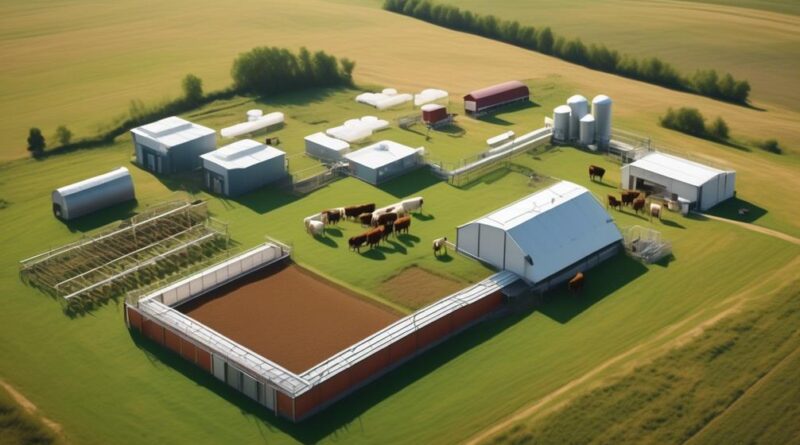Integrating Technology for Streamlined Cattle Farming: A Guide
If you've ever wondered how technology can revolutionize cattle farming, you're in for a treat. Imagine being able to remotely monitor the health of your herd, automate feeding processes, and optimize grazing patterns with the help of data-driven insights.
These are just a few examples of how integrating technology can streamline cattle farming operations. But how exactly can these advancements benefit your farm?
Stay tuned to discover how technology is reshaping the cattle farming landscape and how it can help you maximize efficiency and productivity on your farm.
Precision Livestock Management
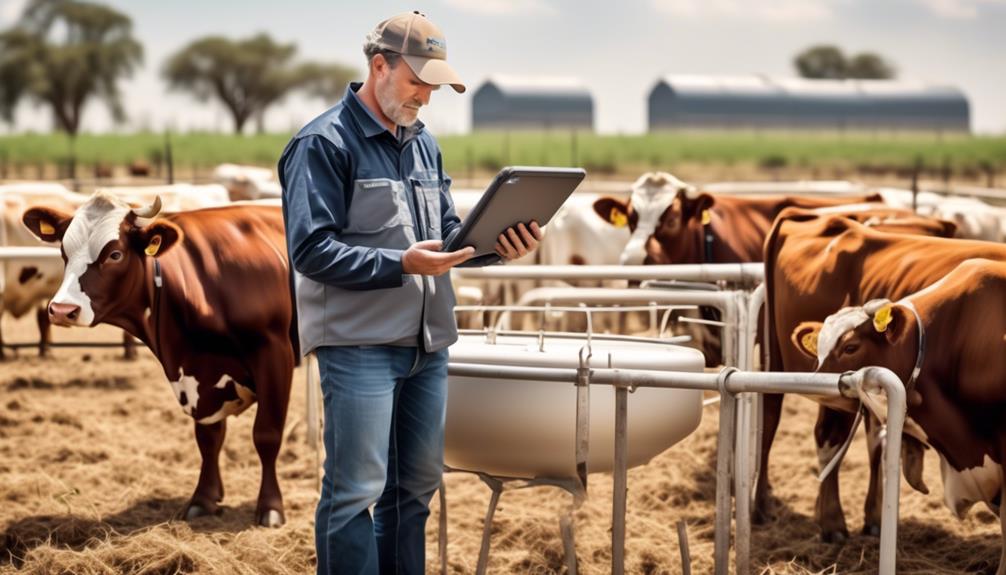
How can you use integrated technology to monitor and manage the health and behavior of your cattle with precision and efficiency?
By leveraging advanced data analysis and real-time monitoring, you can gain valuable insights into your cattle's behavior and overall well-being. Integrated technology allows you to collect and analyze data on factors such as feeding patterns, activity levels, and even social interactions within the herd to better understand the health and behavior of individual animals and the herd as a whole.
With the help of integrated technology, you can track changes in animal behavior, which can serve as early indicators of potential health issues. By monitoring factors such as movement patterns and feeding behavior, you can quickly identify deviations from normal patterns that may signal illness or distress. This proactive approach enables you to address potential health concerns promptly, ultimately leading to better overall herd health and reduced risk of disease spread.
Furthermore, data analysis tools can provide valuable insights into the effectiveness of your livestock management strategies. By tracking and analyzing data on feeding practices, environmental conditions, and animal behavior, you can make informed decisions to optimize feeding programs, enhance living conditions, and improve overall animal welfare. This data-driven approach empowers you to fine-tune your management practices for better outcomes, ultimately leading to healthier, more contented cattle and improved operational efficiency.
Automated Feeding Systems
Implementing automated feeding systems can streamline the process of distributing feed to your cattle, ensuring consistent and timely nutrition while reducing manual labor. These systems are designed to optimize feeding efficiency by delivering the right amount of feed at the right time, minimizing waste and ensuring that all cattle receive their required nutrition. By automating the feeding process, you can significantly reduce the time and effort required for manual feeding, leading to substantial labor savings.
Automated feeding systems utilize technology to precisely measure and distribute feed, eliminating the need for manual scooping and distribution. This not only saves time but also ensures that each animal receives the correct portion, promoting better overall health and growth. The ability to program feeding schedules and portion sizes allows for a consistent and controlled diet, contributing to improved cattle management and productivity.
Moreover, these systems can be integrated with data collection and analysis tools, providing insights into feeding patterns, consumption rates, and overall herd health. This data-driven approach enables you to make informed decisions about feed management, leading to better resource utilization and cost savings.
Remote Health Monitoring
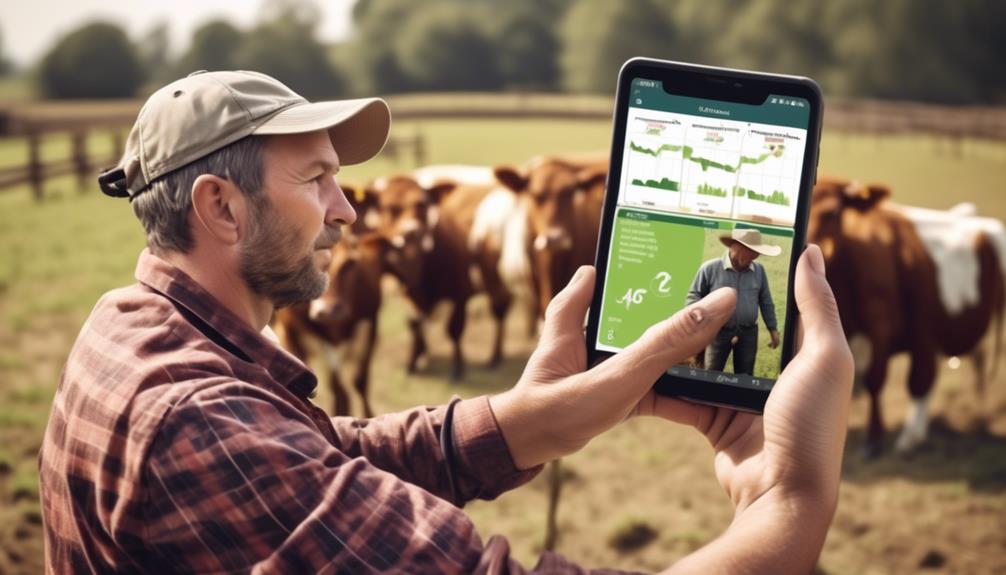
Remote health monitoring for your cattle allows you to track their well-being and detect potential issues without the need for physical presence. By utilizing advanced technology, you can continuously monitor your cattle's health and address any concerns promptly. Cattle wellness is a crucial aspect of farming, and remote health monitoring provides real-time data on vital signs, activity levels, and overall behavior.
This proactive approach enables you to identify any deviations from normal patterns, indicating potential health issues before they escalate.
Remote diagnostics play a key role in maintaining the health of your cattle. With the help of sensors and connected devices, you can receive alerts regarding any irregularities in your cattle's health. This allows you to intervene early, minimizing the risk of illness or disease spread within your herd. Additionally, remote health monitoring provides valuable insights into the effectiveness of your cattle management practices, enabling you to make informed decisions for their well-being.
Incorporating remote health monitoring into your cattle farming operations not only enhances the efficiency of health management but also saves time and resources. With the ability to remotely assess the health status of your cattle, you can allocate your physical presence where it's most needed, thereby optimizing your farming efforts.
Embracing technology for remote health monitoring empowers you to elevate the overall health and productivity of your cattle.
Data-Driven Breeding Programs
Harnessing the real-time health data collected through remote monitoring, you can now leverage data-driven breeding programs to optimize the genetic potential of your cattle herd. By analyzing the health and performance data of individual animals, you can make informed decisions about genetic selection and breeding performance to enhance the overall quality of your herd.
Data-driven breeding programs allow you to identify the best genetic traits within your herd and make strategic breeding decisions. Through the use of advanced analytics, you can pinpoint specific genetic markers associated with desirable traits such as disease resistance, growth rate, and milk production. This information empowers you to selectively breed cattle with the most favorable genetic attributes, ultimately improving the overall quality and productivity of your herd.
Furthermore, these programs enable you to track and assess the breeding performance of individual animals over time. By monitoring factors such as reproductive success, offspring quality, and overall health, you can evaluate the effectiveness of specific breeding pairings and adjust your breeding strategy accordingly. This proactive approach to breeding ensures that you're continually optimizing the genetic potential of your herd and working towards long-term improvements in cattle quality and productivity.
Smart Grazing Technologies
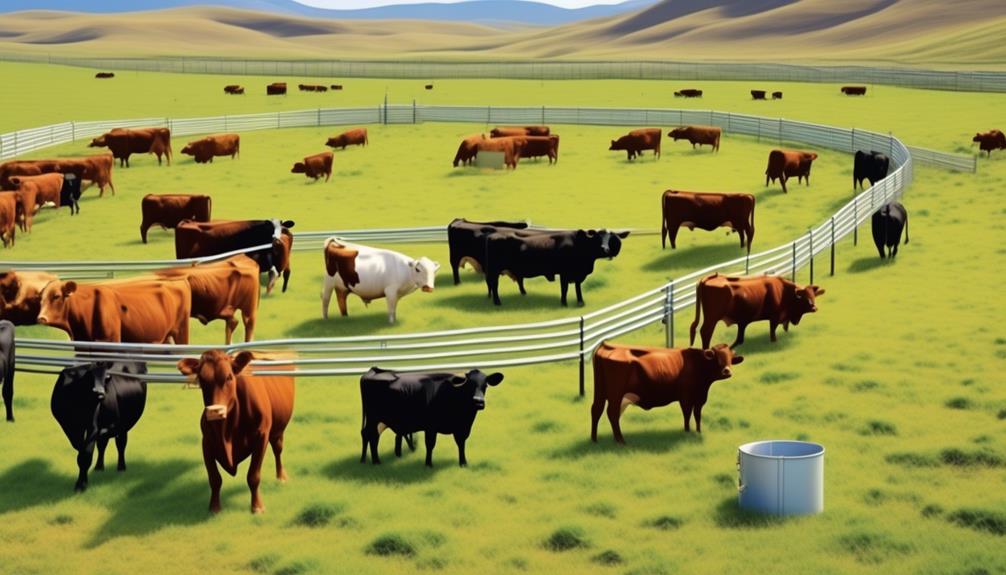
To optimize the grazing efficiency of your cattle, consider integrating smart grazing technologies that can enhance pasture management and animal welfare. Smart grazing technologies offer innovative solutions to monitor and improve grazing behavior and pasture management, ultimately leading to better productivity and animal well-being.
Smart grazing technologies utilize GPS tracking and real-time monitoring to analyze your cattle's grazing patterns. By understanding their grazing behavior, you can strategically plan pasture rotations, preventing overgrazing in certain areas and allowing for optimal regrowth. This not only improves the overall health of your pastures but also ensures a consistent and nutritious food supply for your cattle.
Additionally, these technologies can provide insights into the health and well-being of individual animals within the herd, allowing for early detection of any issues. By closely monitoring grazing behavior, you can identify any changes that may indicate illness or distress, enabling prompt intervention and care.
Furthermore, smart grazing technologies contribute to efficient pasture management by enabling remote monitoring and control. You can use automated systems to adjust grazing areas or deploy virtual fencing, optimizing the use of available pasture resources.
In essence, integrating smart grazing technologies into your cattle farming practices can revolutionize pasture management and enhance the welfare of your animals. By leveraging real-time data and insights, you can make informed decisions that benefit both your cattle and your farm's productivity.
Real-time Environmental Monitoring
Enhancing your cattle farming practices with smart grazing technologies not only improves pasture management and animal welfare but also sets the stage for real-time environmental monitoring. Through real-time environmental monitoring, you can gain valuable insights into weather forecasting and soil quality, allowing you to make proactive decisions for the well-being of your cattle and the sustainability of your farm.
Weather forecasting plays a crucial role in cattle farming as it directly impacts grazing patterns, forage availability, and overall animal health. With real-time environmental monitoring technology, you can access up-to-date weather data specific to your farm, enabling you to anticipate and prepare for adverse weather conditions such as storms or extreme heat. By doing so, you can take timely actions to protect your cattle and optimize grazing strategies.
Furthermore, real-time environmental monitoring provides essential information about soil quality, which is fundamental for sustainable pasture management. By continuously monitoring soil moisture, nutrient levels, and pH balance, you can make informed decisions regarding grazing rotation, fertilization, and irrigation. This proactive approach ensures that your pastures remain productive and healthy, contributing to the overall well-being of your cattle and the long-term sustainability of your farm.
Automated Waste Management Solutions
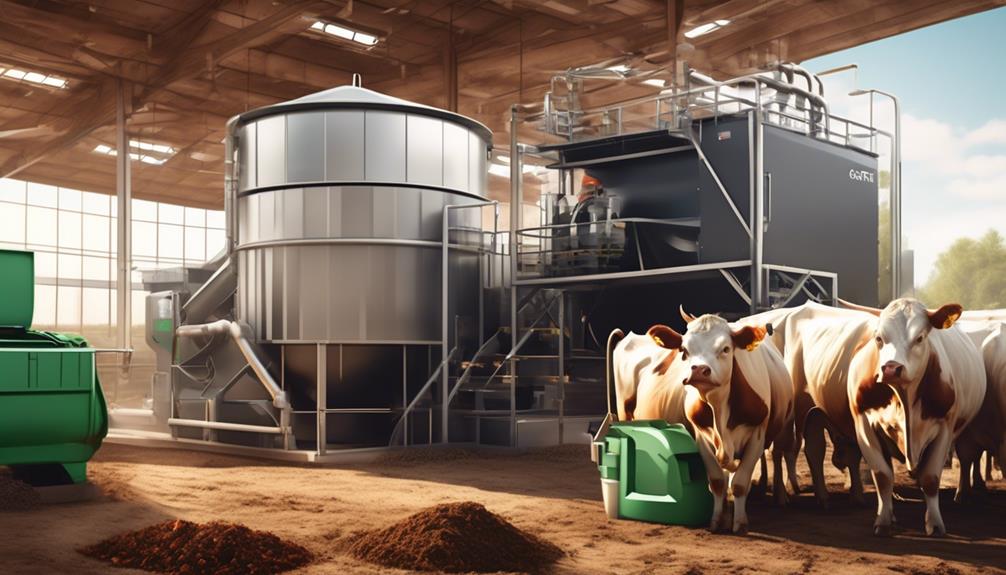
One efficient way to manage waste on your cattle farm is by implementing automated waste management solutions that streamline the disposal process and minimize environmental impact. Waste composting is a key aspect of automated waste management. By using specialized machinery, organic waste such as manure and feed remnants can be efficiently composted, turning them into valuable fertilizer for your fields. This not only reduces the amount of waste that needs to be disposed of but also provides a sustainable way to enhance soil fertility on your farm.
In addition to waste composting, automated systems can also help control emissions from waste. These systems are equipped with advanced technology to manage and reduce greenhouse gas emissions from manure and other organic waste. By effectively controlling emissions, you can minimize the environmental impact of your cattle farming operations and contribute to sustainable agricultural practices.
Automated waste management solutions offer a range of benefits for your cattle farm, including increased efficiency, reduced manual labor, and improved environmental stewardship. With these systems in place, you can optimize waste management processes, mitigate potential environmental issues, and even create additional value from organic waste through composting. By embracing automated waste management solutions, you can ensure that your cattle farm operates in an environmentally responsible and sustainable manner.
Integrated Supply Chain Solutions
Implementing integrated supply chain solutions can significantly improve the efficiency and coordination of your cattle farming operations. Supply chain optimization and inventory management are essential components to ensure a smooth flow of resources and products within your operation.
By integrating technology into your supply chain, you can track inventory levels in real-time, anticipate demand, and streamline the procurement process. This not only minimizes wastage but also ensures that you always have the necessary resources at hand, preventing any disruptions to your farming activities.
Logistics automation plays a crucial role in enhancing distribution efficiency. With automated systems in place, you can efficiently manage transportation, storage, and delivery of cattle and related products. Automated inventory tracking and management systems can help in reducing manual errors, ensuring accurate stock levels, and facilitating timely replenishment.
Moreover, automation can assist in optimizing delivery routes, reducing transit times, and ultimately lowering transportation costs. By leveraging logistics automation, you can enhance the overall speed and reliability of your supply chain, thereby improving the profitability of your cattle farming operations.
Frequently Asked Questions
How Can Technology Help With the Branding and Identification of Cattle on the Farm?
Technology can revolutionize cattle branding and identification. With RFID and GPS tracking, you can efficiently monitor and manage livestock. Cattle tracking systems streamline the process, ensuring accurate identification and efficient management of your herd.
What Are the Potential Cybersecurity Risks Associated With Implementing These Technological Solutions on a Cattle Farm?
When integrating technology on a cattle farm, you should be aware of potential cybersecurity risks and data privacy concerns. Implementing technological solutions requires safeguarding against unauthorized access and protecting sensitive information from potential breaches.
Are There Any Ethical Considerations When Using Data-Driven Breeding Programs for Cattle?
When using data-driven breeding programs for cattle, ethical considerations are crucial. Balancing genetic selection with animal welfare is essential. Ensure that technology is used responsibly to maintain the well-being of the animals.
How Can Technology Be Utilized to Improve the Efficiency of Cattle Transportation and Logistics Within the Integrated Supply Chain?
You can improve cattle transportation efficiency by utilizing GPS technology for cattle tracking and automated feeding and monitoring systems. This streamlines logistics within the integrated supply chain, ensuring better management and reduced transportation costs.
What Are the Potential Challenges and Limitations of Implementing Smart Grazing Technologies in Different Environmental Conditions?
You'll face various challenges when implementing smart grazing tech in diverse environments. It requires adaptation to factors like terrain, weather, and vegetation. Overcoming these hurdles is crucial for successful integration and maximizing efficiency.
Conclusion
In conclusion, integrating technology into cattle farming can streamline operations, improve productivity, and enhance animal welfare.
By utilizing precision livestock management, automated feeding systems, remote health monitoring, data-driven breeding programs, smart grazing technologies, real-time environmental monitoring, automated waste management solutions, and integrated supply chain solutions, farmers can optimize their processes and ultimately achieve greater success in the industry.
Embracing technology is the key to modernizing cattle farming and ensuring a sustainable future for the industry.
